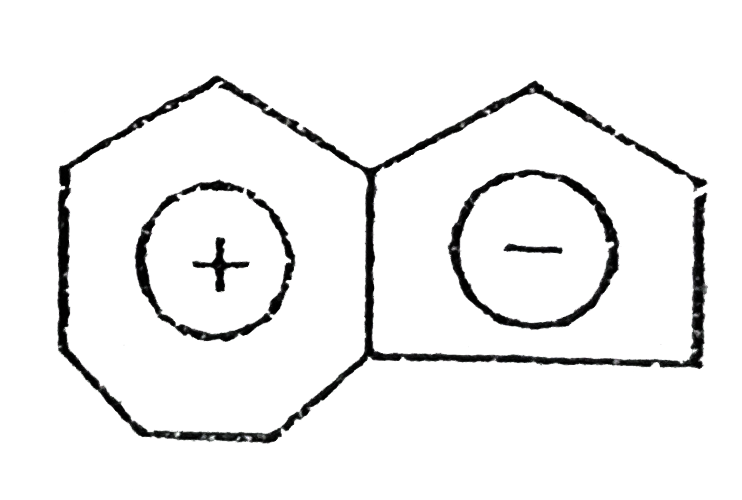Statement-1: Me−⊕CH2 is more stable than MeO −CH⊕2
Statement-2: Me is a+I group where as MeO is a –I group.
Statement-1 is true, statement-2 is true and statement-2 is correct explanation for statement-1.
Statement-1 is true, statement-2 is true and statement-2 is NOT correct explanation for statement-1.
Statement1 is false, statement-2 is true.
Statement1 is true, statement-2 is false.
The correct Answer is:C
To analyze the given statements, we will evaluate the stability of the carbocations mentioned in Statement-1 and the effects of the groups mentioned in Statement-2.
1. Understanding the Carbocations:
- We have two carbocations to compare:
- Me-CH2^+ (where Me = CH3)
- MeO-CH2^+ (where MeO = CH3O)
2. Evaluating the Stability of Me-CH2^+:
- The Me (methyl) group is an electron-donating group due to its +I (positive inductive) effect. This means it can donate electron density to the positively charged carbon, stabilizing the carbocation.
- Therefore, the stability of Me-CH2^+ is enhanced due to the +I effect of the methyl group.
3. Evaluating the Stability of MeO-CH2^+:
- The MeO (methoxy) group has a –I (negative inductive) effect due to the electronegativity of oxygen. This means it withdraws electron density from the positively charged carbon, which destabilizes the carbocation.
- However, the oxygen atom has lone pairs that can participate in resonance, providing some stabilization through resonance (mesomeric effect). This effect can sometimes outweigh the –I effect, but in this case, the overall effect is still destabilizing due to the strong –I effect.
4. Comparison of the Two Carbocations:
- Since the +I effect of the methyl group is stronger than the –I effect of the methoxy group, Me-CH2^+ is more stable than MeO-CH2^+.
- Thus, Statement-1 is false.
5. Analyzing Statement-2:
- Statement-2 claims that Me is a +I group and MeO is a –I group.
- This is correct because the methyl group indeed has a +I effect, and the methoxy group exhibits a –I effect due to the electronegativity of oxygen.
- Therefore, Statement-2 is true.
Conclusion:
- Statement-1 is false: Me-CH2^+ is more stable than MeO-CH2^+.
- Statement-2 is true: Me is a +I group, while MeO is a –I group.
Final Answer:
- Statement-1: False
- Statement-2: True
- We have two carbocations to compare:
- Me-CH2^+ (where Me = CH3)
- MeO-CH2^+ (where MeO = CH3O)
- The Me (methyl) group is an electron-donating group due to its +I (positive inductive) effect. This means it can donate electron density to the positively charged carbon, stabilizing the carbocation.
- Therefore, the stability of Me-CH2^+ is enhanced due to the +I effect of the methyl group.
- The MeO (methoxy) group has a –I (negative inductive) effect due to the electronegativity of oxygen. This means it withdraws electron density from the positively charged carbon, which destabilizes the carbocation.
- However, the oxygen atom has lone pairs that can participate in resonance, providing some stabilization through resonance (mesomeric effect). This effect can sometimes outweigh the –I effect, but in this case, the overall effect is still destabilizing due to the strong –I effect.
- Since the +I effect of the methyl group is stronger than the –I effect of the methoxy group, Me-CH2^+ is more stable than MeO-CH2^+.
- Thus, Statement-1 is false.
- Statement-2 claims that Me is a +I group and MeO is a –I group.
- This is correct because the methyl group indeed has a +I effect, and the methoxy group exhibits a –I effect due to the electronegativity of oxygen.
- Therefore, Statement-2 is true.
- Statement-1 is false: Me-CH2^+ is more stable than MeO-CH2^+.
- Statement-2 is true: Me is a +I group, while MeO is a –I group.
- Statement-1: False
- Statement-2: True
Topper's Solved these Questions
- BOOK - MOTIONCHAPTER - GOCEXERCISE - Exercise - 2 (Level - II)114videos
GOC
- BOOK - MOTIONCHAPTER - GOCEXERCISE - Exercise - 344videos
GOC
- BOOK - MOTIONCHAPTER - GOCEXERCISE - Exercise - 130videos
GOC
- BOOK - MOTIONCHAPTER - GASEOUS STATE EXERCISE - EXERCISE-4( LEVEL-II)19videos
GASEOUS STATE
- BOOK - MOTIONCHAPTER - GRIGNARD REAGENTEXERCISE - EXERCISE-216videos
GRIGNARD REAGENT
Similar Questions
Knowledge Check
- Question 1 - Select One
Statement-1: CH3CH2⊕CH2 is less stable than CH3−N∣H−⊕CH2
and
Statement-2: Carbocation with adjacent hetero-atom like N O are less stable .AStatement -1 is True, Statement -2 is True, Statement -2 is a correct explanation for Statmenet -1.BStatement -1 is True, Statement -2 is True, Statement-2 is NOT a correct explanation for Statement -1CStatement -1 is True, Statement -2 is FalseDStatement -1 is False, Statmenet -2 is True - Question 2 - Select One
The stability of Me2C=CH2 is more than that of MeCH2CH=CH2 due to :
Ainductive effect of the Me groupBresonance effecta of the Me groupChypercojugative effect of the Me groupDresonance as well as inductive effect of the Me group - Question 3 - Select One
The stability of Me2C=CH2 is more than that of MeCH2CH=CH2 due to :
AInductive effect of the Me groupBResonance effect of the Me groupCHyperconjugative effect of the Me groupDResonance as well as inductive effect of the Me group
Me3CCH2COOHis more acidic than Me3SiCH2COOH.
View SolutionExplain why (CH3)3+Cis more stable than CH3+CH2 and CH3 is the least stable cation
View SolutionStatement-I: CH3−O∣∣C−CH2−O∣∣C−CH3 is more acidic than CH3−CO2H
Statement-II: Above active methylene hydrogen is less acidic than carboxylic acid.View SolutionAssertion(A):Me3−C is more stable than −CH3.
The +I effect of the three Me groups in Me3−C tends to make it more stable than −CH3.View SolutionAssertion: tert-Butyl carbanion is less stable than methyl carbanion.
Reason: The +1-effect of the CH3 groups tends to stablize the tert-butyl carbanion.View Solution


 is antiaromatic molecule
is antiaromatic molecule